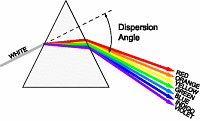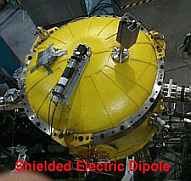|
The DRAGON System
(To take an interactive tour of the DRAGON system, see
below.)
|
The DRAGON apparatus is what is known as a recoil mass spectrometer.
A spectrometer is an instrument that is able to separates a things according
to a set
of criteria. The simplest example of a spectrometer is a prism. A prism
can separate white light into all its components wavelengths: red,
orange, yellow, green, blue, indigo, and purple. A mass spectrometer
(such as DRAGON) separates not light but particles. Given a mixture of
particles, it will separate them according to their mass.
|
 |
 |
Before DRAGON can do its job, we have to create some particles to separate!
This is done in the gas target. We fill the target with either hydrogen or
helium (their nuclei being protons and alpha particles respectively), and
pass a beam of radioactive particles generated by the ISAC facility through it.
In order that the beam may pass unobstructed, an opening is located on either
side of the target (the "enter" and "exit", repsectively). This poses some
problems, however, because the beamline needs to stay as close as possible to
a perfect vacuum. This problem has been solved by "simply" pumping away any gas
that might leak out of the gas target as quickly as possible.
|
|
The 'recoils' DRAGON was designed to detect are simply the product of the
nuclear reaction which is being studied. For example, when studying a beam of
21Na (sodium with 11 protons and 10 neutrons) the
recoils we would be separating and then detecting are 22Mg
(magnesium with 12 protons and 10 neutrons). The tricky part is
separating the recoils from the incoming beam. This is made especially
difficult because there are so few recoils compared to beam particles.
(roughly, we expect one recoil for every 1x108 of incoming
particles). This is where the mass spectrometer comes in.
|
 |
 |
The mass spectrometer has two components that work together to separate
the particles. These are the magnetic dipoles and
the electric dipoles.
The magnetic dipoles are able to separate the particles by their charge,
since particles with different charge are bent by different amounts in a
magnetic field. The magnet is set so that it will bend the charge state we
are interested in (the one the recoils are most likely
to be found in) just the right amount so that the particles with that
charge state pass through the charge slits and all the others get
trapped in the charge slit box.
|
|
The particles leaving the magnetic dipoles have one charge state but a mixture
of masses. To separate the remaining particles
by mass, we use an electric dipole. The beam particles and the recoil
particles both leave the gas target with the same momentum. This is useful
because if they both have the same momentum but different masses, they will
have different velocities, and hence, different kinetic energies. The
electric dipole is able to separate particles based on their kinetic energies.
As with the magnetic dipole, we chose the kinetic energy we are interested in
(that of the recoils), and apply the right charge to
the electric dipole so that the recoils pass through to our detector.
A stage of the mass separator consists of a magnetic dipole, an electric
dipole and focusing magnets. At the end of the
stage, ions of the same mass but differing initial angles or energies are refocused to the same position, while ions of differing masses arrive at different horizontal positions. Slits are set to allow the desired recoil ions to pass, while blocking the unwanted lower-mass beam ions. The DRAGON separator consists of two stages in series.
|
 |
There are several detectors found at the end of
the mass spectrometer,
each measuring a different quantity. They can be used alone or in combinations
depending on the precision and type of data needed in the experiment. In
addition, there is an array of gamma
detectors located around the gas target.
These detect the gamma rays given off in most capture reactions.
The coincidence between 'seeing' a gamma emission of the right energy and
detecting a recoil event gives us confidence that we are detecting
recoil atoms, and not beam particles.
|









